BY JEFFREY RESSNER
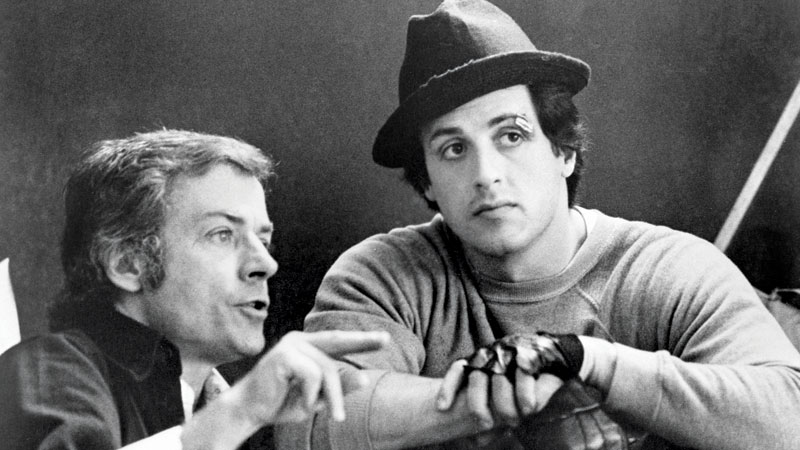
“Gonna fly now...gonnaa flyyyy now,” sings a soaring chorus on the soundtrack of John Avildsen’s Rocky (1976) as an underdog hero with hangdog eyes, Rocky Balboa (Sylvester Stallone), jogs through the streets of Philadelphia, jabbing at the air to prepare for his big chance in the boxing ring. Training montages had been done before, but perhaps for the first time this one helped move the story line forward and significantly developed the lead character.
With the entire picture shot in 28 days on a $1.1 million budget, most of the training montage was filmed during a quick preproduction trip to Pennsylvania with a skeleton crew. Avildsen patched together the largely improvised sequence on the spot. Joining the crew was Garrett Brown, a novice inventor who had just built a unique mounting system that allowed a movie camera to “float” freely while the DP gently guided it by hand. The jerry-rigged, stabilizing mechanism was all but unknown. But the Steadicam, as it would soon be called, would go on to revolutionize how movies were shot.
Rocky grossed $225 million worldwide and Avildsen won the DGA Award and an Oscar for best director. Over the years the iconic sequence has been endlessly copied and caricatured, yet its powerful, triumphant climax atop the steps of the Philadelphia Museum of Art still sends chills through those seeing it for the first, or the hundredth time.
This first shot by the railroad tracks was filmed just as the sun was going down, so we were able to get a great sky here. And I deliberately chose a rough and tumble location because, well, Rocky is a rough and tumble guy. There's nothing complicated about him running right up to the camera and then the camera following him as he passes by—it's just a simple pan. Our producers wanted to shoot the whole movie in Hollywood, but I felt that Philadelphia was a big part of the story, so I convinced them to let us shoot there for three or four days.
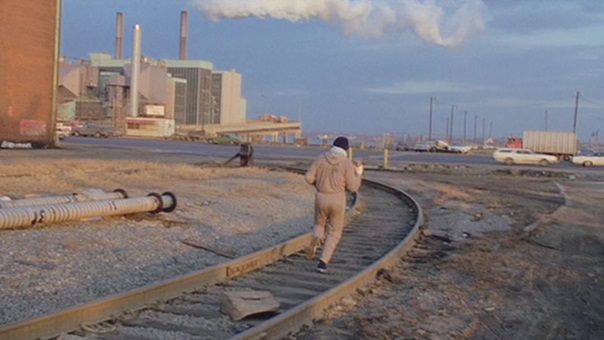
Rocky is running through the railroad tracks here, continuing the action from the previous frame. It's all one shot—he starts running toward us, we pan with him as he runs by, and then he runs away from us. He's running right on the actual tracks because it looks much more dramatic and dynamic that way—he's like a train. This whole montage sequence was shot during the first few days of production, and if I had to choose one word to describe the overall mood it would be 'hurried.' It was always 'Next! Next! Next!' But thankfully it wasn't too cold in Philadelphia for November. Then we turned around and started shooting back in Los Angeles in January.

When I saw this Italian market full of food stalls on South 9th Street, it seemed a natural place for Rocky to run. We shot all of the market scenes twice, once with a 35 mm lens and then again with a 75 mm. I like doing it that way because it gives me an option to cut, and I have two different sizes to work with. We shot this through the back doors of a small Ford rental van. We didn't have permits, equipment, or any extras, we just had a few camera people, so we shot the entire thing guerrilla style. During the filming, a stall owner tossed Sylvester an orange and, luckily for us, he caught it. The move was completely improvised; the guy had no idea a movie was being filmed or that he would be in it.

We opened both of the van's rear doors and tied them back securely with a rope, and put an apple box on the floor for Garrett to sit on. He then shot Sylvester with the Steadicam, which took a lot of the bounce off of the bumpy ride. In those days, the Steadicam prototype was held together with lots of gaffer's tape and rubber bands. It had a tiny video screen near the bottom base that was about the size of a 3x5 index card and it gave off a greenish color instead of a black-and-white image. I think it was some kind of video playback unit he got from a submarine or something. To be honest, the screen was so bad it was really hard to discern anything. But whenever you say 'Action!' you've got to have faith that things will come together.
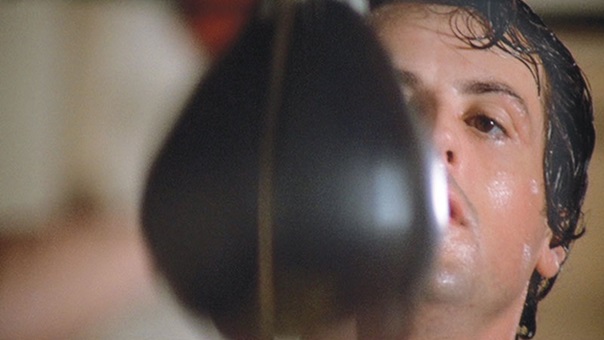
The series of interiors at Mickey's Gym were all shot a couple of months later when we were back in California. Sylvester trained for nearly half a year before we started filming, and from when we were back East until we shot in L.A., he had been doing a lot of practicing on the speed bag. By the time we came around to shoot he was getting pretty good at it. I had never shot a workout scene before, and wasn't particularly a fan of boxing movies, but I knew what looked good.
Sylvester showed me these one-handed push-ups right before we filmed them, so I said, 'Great, just do it again and let's get it on film.' The script had a shot written for several two-handed push-ups, but he said that something crazy happened every time the camera rolled and before I knew it, he was flying from one hand to another doing an exercise that no boxer in his right mind would ever do. He later said he inflamed every joint in his body but thought it was worth it for the sake of the picture.
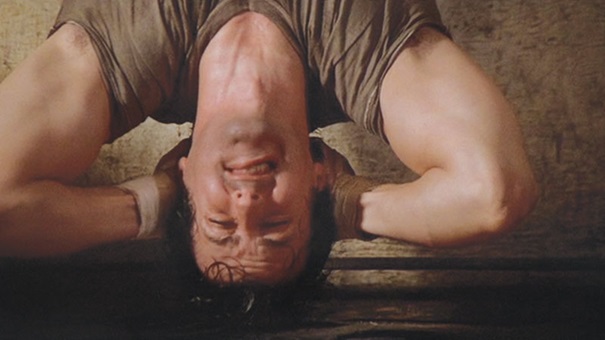
The extreme sit-ups were done from the same camera position we used to shoot the one-handed push-ups. The camera was on short legs, and Sylvester was sitting on the edge of the canvas, looking in toward the center of the ring. He leaned over backward in order to hang with his head pointing down, then sat up. I decided on a medium shot because it was more dramatic that way—you saw him upside down and then going up, and upside down, then going up. I wanted to get in as close as possible to fill the entire screen with his shoulders and muscles and face. After all, that's what we were selling. Since he was such a great athlete, we didn't need to do anything extraordinary.
We shot inside the meat locker only once, for the scenes when he talks to Paulie and later when he's being interviewed by the TV reporter. But we were in there for something like 12 hours, so I used some of the footage later on when I edited the montage. We bandaged up Sylvester's hands the same way a boxer's hands are taped before they put on their gloves, nothing fancy. The location itself was a small meat packing plant in Culver City that's not there anymore. The Steadicam allowed us to show Sylvester's full force slamming into the sides of beef, and Sylvester said he pounded them so hard and for so long that he cracked the knuckles on his hand.
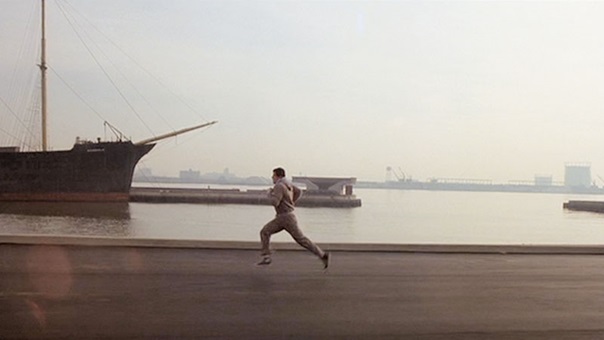
This running shot was filmed with a baby legs tripod, which is used for getting shots a few feet above the ground. That boat was just a ship that happened to be moored there when we were driving by. So we used the tripod and the Arri, which we pointed out the side of the van as we were driving alongside him. I told Sylvester, 'Okay, you start running here and I'll start here, and run by the ship.' The most dramatic moment happens when he gets a burst of energy and sprints across the dockside at lightning speed. During some interviews later on, Sylvester said that he felt himself almost losing balance until we went through some trial runs. But I don't remember any trial runs. We didn't have time.
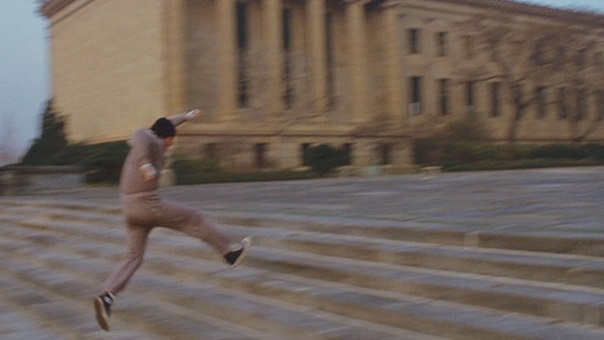
When I first saw Garrett's test reel for the camera he'd invented, the opening shot had his girlfriend running up the stairs of the Philadelphia Museum of Art. Funny enough, in the original script, Rocky himself runs up the stairs twice. So when I saw Garrett's smooth camerawork in the demo reel, it all seemed like a happy coincidence. Hopping up the last few stairs was something Sylvester came up with. Because Rocky had tried to run up the stairs earlier but failed, we now had to show the joy he expressed from finally reaching the top. We needed to show the pride glowing in Sylvester's face. In this instance, a figure coming at you is more dramatic than someone going away from you—more often than not you want to see the person's face, and at a certain point you start to go with him.
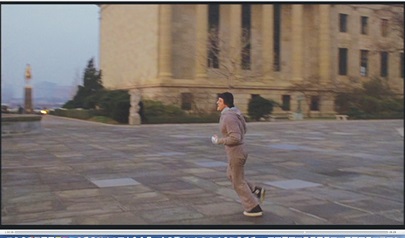
There really didn't need to be that much blocking for this. I just told Sylvester to start at the bottom and stationed Garrett near the top. I explained to Garrett that when Sylvester ran up and was opposite him, he was to run right along with him and up the stairs, hold onto him as a full figure, then come around and move in closer for just a head and shoulders shot at the end. That's what was so great about using the Steadicam—we could do all of this stuff without having any big crews and a fancy crane and God knows what else. If it wasn't for the Steadicam, it would have been a very time-consuming exercise.

When Sylvester holds his hands up in victory, it's a pose that goes back to ancient Greek and Roman sculpture. Right then, the music swells to a climax. When I heard Bill Conti scoring this, I told him it was a terrific tune but he should put in some words and turn it into a real song. So Conti took a little break, and with a couple of others they came up with all the lyrics in about five minutes. I remember I liked this whole montage sequence so much I kept asking Bill to write more music so we could make it longer. There were three or four times when I asked if he could just add another 15 or 20 seconds.
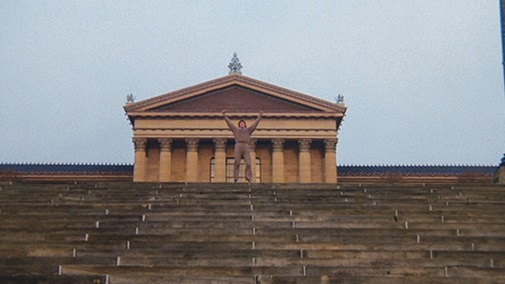
I made this shot from the bottom of the stairs with an Arriflex on a tripod. Originally I was all the way in on Sylvester doing his little dance at the top of the stairs, then I fully zoomed out and that was the entire shot. When the editing began, I had some music I was using to cut the montage together, just a temp track. I usually find some appropriate score until the actual composer finishes the real music, and then I recut the footage to fit the new tempo. When it came to this shot at the top of the stairs with me at the bottom zooming out, it didn't go with the new music. So I decided to reverse the shot, which was easy enough to do in the lab. So now it looks like I'm zooming in instead of pulling back
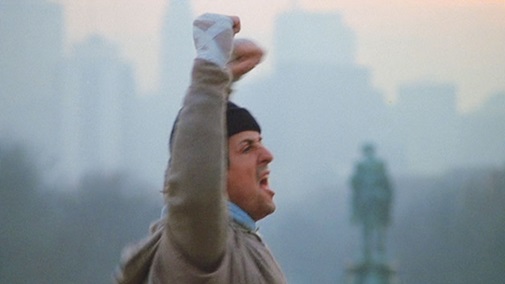
We were at the museum for about two hours that day, first shooting the earlier scene in which Rocky's out of shape, then the follow-up where he's in great shape. We started shooting the first scene before the sun came up and, by the time we finished, the sun was rising, so we immediately started shooting him again for the second sequence. It was more dynamic and the sky had lightened up some. There were no editing cuts in the second sequence, so I told Garrett to come in close to Sylvester as he was pumping his fists in the air so we could see his upper torso and face, while the entire city made up the background. The Steadicam allowed us to do these kind of shots very easily.